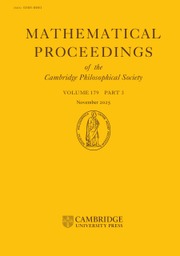On block Behrend sequences
Published online by Cambridge University Press: 24 October 2008
Extract
Let A be a strictly increasing sequence of integers exceeding 1 and let

denote its set of multiples. We say that A is a Behrend sequence if M(A) has asymptotic density 1. The theory of sets of multiples was first developed in the late thirties, under the influence of Erdős, Besicovitch, and others. An account of the classical notions is presented in the book of Halberstam and Roth (1966), and recent progress in the area may be found in Hall and Tenenbaum [7], Erdős and Tenenbaum [4], Ruzsa and Tenenbaum [9]. As underlined by Erdős in [3], one of the central problems in the field is that of finding general criteria to decide whether a given sequence A is Behrend.
Information
- Type
- Research Article
- Information
- Mathematical Proceedings of the Cambridge Philosophical Society , Volume 120 , Issue 2 , August 1996 , pp. 355 - 367
- Copyright
- Copyright © Cambridge Philosophical Society 1996
References
REFERENCES
[1]Davenport, H. and Erdős, P.. On sequences of positive integers. Acta Arith. 2 (1937), 147–151.CrossRefGoogle Scholar
[2]Davenport, H. and Erdős, P.. On sequences of positive integers. J. Indian Math. Soc. 15 (1951), 19–24.Google Scholar
[3]Erdős., P.Some unconventional problems in number theory. Astérisque 61 (1979), 73–92.Google Scholar
[4]Erdős., P., Hall, R. R. and Tenenbaum, G.. On the densities of sets of multiples. J. reine angew. Math. 454 (1994), 119–141.Google Scholar
[6]Hall, R. R. and Tenenbaum, G.. Divisors (Cambridge University Press, 1988).CrossRefGoogle Scholar
[7]Hall, R. R. and Tenenbaum, G.. On Behrend sequences. Math. Proc. Camb. Phil. Soc. 112 (1992), 467–482.CrossRefGoogle Scholar
[8]Maier, H. and Tenenbaum, G.. On the set of divisors of an integer. Invent. Math. 76 (1984), 121–128.CrossRefGoogle Scholar
[9]Ruzsa, I. and Tenenbaum, G.. A note on Behrend sequences. Acta Math. Hung. (to appear).Google Scholar
[10]Shiu, P.. A Brun–Titchmarsh theorem for multiplicative functions. J. reine angew. Math. 313 (1980), 161–170.Google Scholar
[11]Tenenbaum, G.. Sur la probabilité qu'un entier possède un diviseur dans un intervalle donné. Compositio Math. 51 (1984), 243–263.Google Scholar
[12]Tenenbaum, G.. Uniform distribution on divisors and Behrend sequences. Enseign. Math. to appear.Google Scholar
- 2
- Cited by

